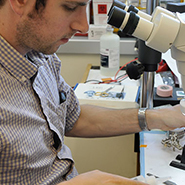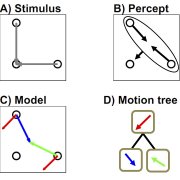Scenes filled with moving objects are often hierarchically organized: the motion of a migrating goose is nested within the flight pattern of its flock, the motion of a car is nested within the traffic pattern of other cars on the road, the motion of body parts are nested in the motion of the body. Humans perceive hierarchical structure even in stimuli with two or three moving dots. An influential theory of hierarchical motion perception holds that the visual system performs a “vector analysis” of moving objects, decomposing them into common and relative motions. However, this theory does not specify how to resolve ambiguity when a scene admits more than one vector analysis. This project explores a Bayesian theory of vector analysis. The theory takes a step towards understanding how moving scenes are parsed into objects.
Development of Intelligence
 Understanding the development of intelligence in a human infant is a key project of CBMM. This project engages the fundamental tradeoff between nature and nurture, or priors and data, and ultimately the origin of priors—how constraints are selected by evolution, encoded in genes, and instantiated in genetically wired brain circuits.
Understanding the development of intelligence in a human infant is a key project of CBMM. This project engages the fundamental tradeoff between nature and nurture, or priors and data, and ultimately the origin of priors—how constraints are selected by evolution, encoded in genes, and instantiated in genetically wired brain circuits.
This project also represents a novel developmental approach to building human-like artificial intelligence systems and comprehensive computational models of human cognitive architecture. Instead of branching out from a single area of adult human intelligence, we start with an integrated cognitive model of multiple core capacities in the young child’s mind, along with a set of developmental or learning mechanisms for scaling up to an adult model.

